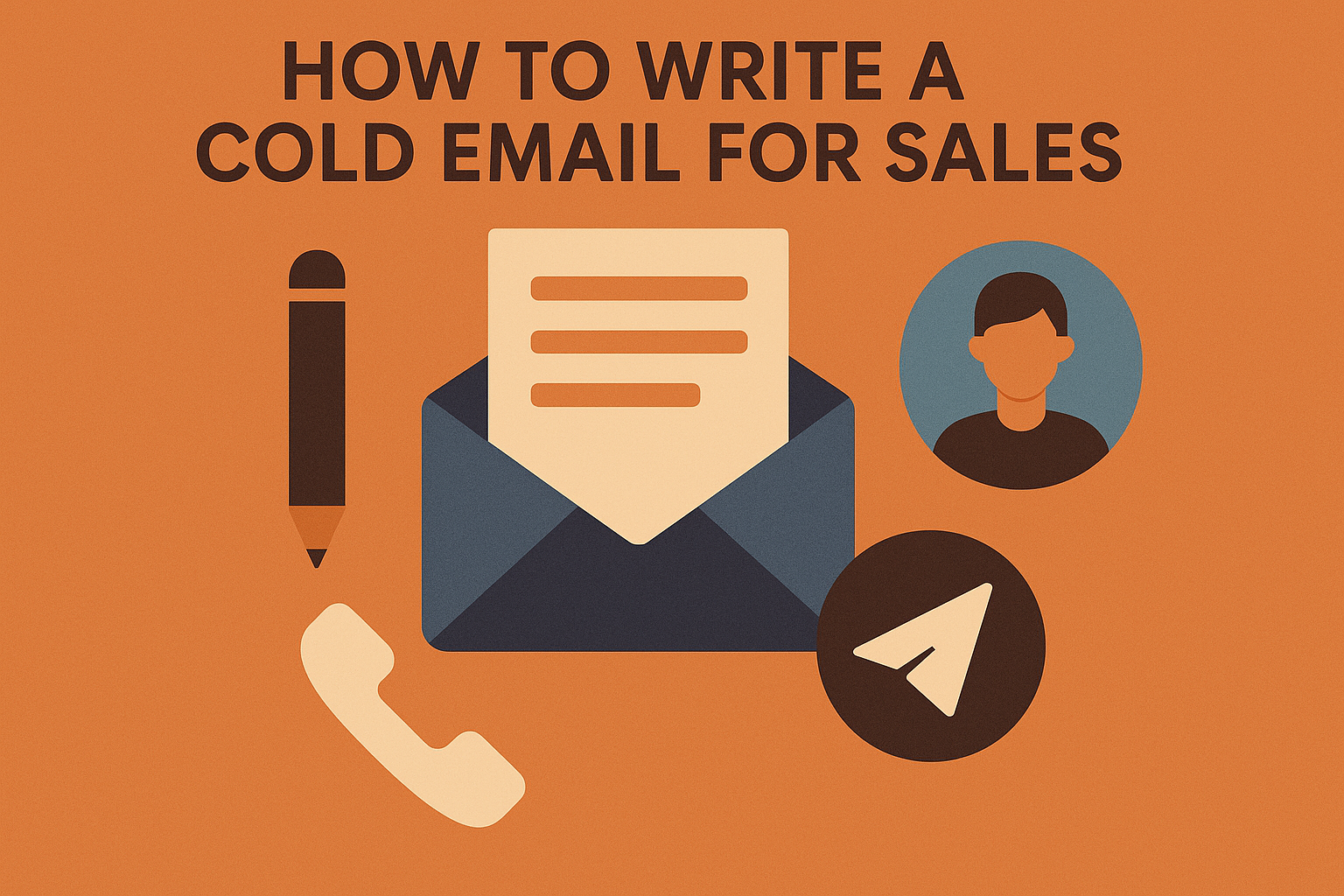How to Write a Cold Email That Converts in 2025 (Free Tips and Template)
Key Takeaways
-
Go into cold email outreach thinking of how you can help, not just sell, concentrating on the recipient.
-
Be empathetic and respectful — appreciate their time and ask permission before proceeding.
-
If formatted properly, your subject lines and opening sentences can ensure that your email gets opened and read.
-
Make every email have an obvious value and a strong call-to-action so it’s easy for people to act.
-
Customize each message with research and with outlines geared to the recipient’s specific challenges and objectives.
-
Steer clear of rookie errors like self-centered language, wishy-washy requests, and not formatting for deliverability and engagement.
To write a cold email for sales, focus on clear subject lines, brief introductions, and direct value to the reader. A powerful cold email employs plain language, genuine purpose, and straightforward calls to action.
Personalizing each note for the recipient goes a long way toward response rates. Standard advice suggests making emails brief, using the reader’s name, and stating what you do immediately.
The following section presents action steps and working examples.
The Modern Cold Email Mindset
Cold email for sales is not simply about pitching. Today, it’s about initiating a genuine dialogue. It’s to craft a bridge, not throw an offer and hope. Everything about the email—from the “from” line to the signature—constructs the first impression.
Personalization is important–a personalized message can boost open rates by 10% or more. It’s about offering VALUE and demonstrating that you comprehend the prospect’s world, not just what you’re trying to sell.
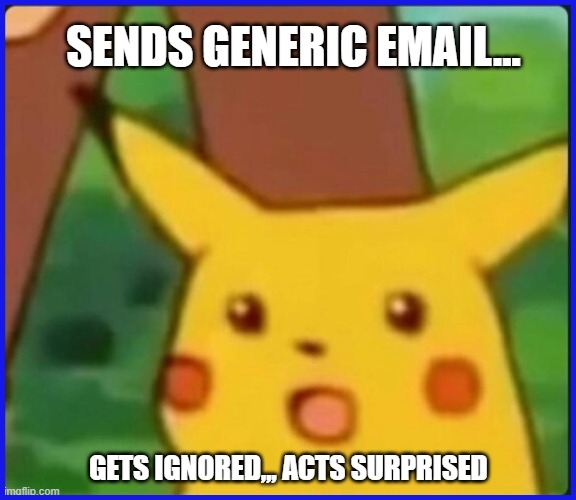
From Pitch to Help
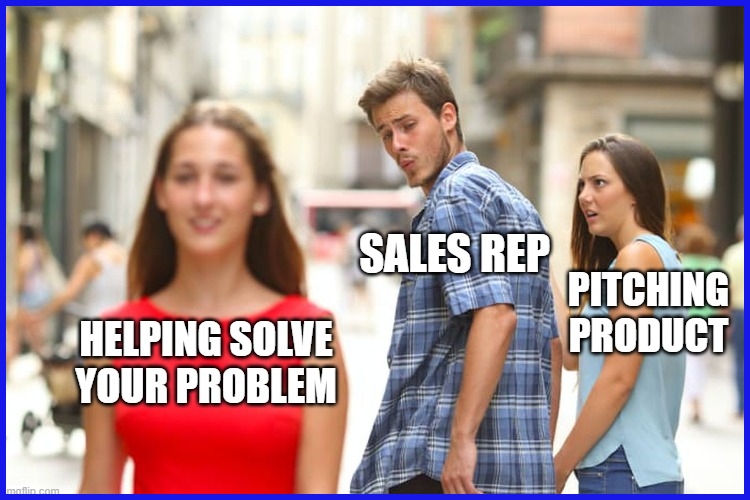
In today’s sales environment, selling is less about pushing a product and more about solving a problem. Prospects want to feel understood, which is why writing cold emails requires thorough research. Reference something unique about their business—perhaps a recent launch or a pain point they’ve shared. For example, ‘I noticed your team recently expanded into Europe. Many companies in your space struggle with tracking regional marketing data—are you facing this issue?’ This approach shows you’re not sending generic emails to everyone.
Additionally, powerful CTAs are essential in cold email campaigns. They should be clear yet non-pushy. Instead of saying, ‘Let’s schedule a call this week,’ you might say, ‘Would you be open to a quick chat about your current reporting process?’ This invites a conversation and makes it easier for them to agree or suggest a different time.
By utilizing effective cold email templates and personalizing your outreach, you can significantly improve your response rate. Understanding your potential clients and crafting tailored messages will help you build meaningful business relationships, ultimately leading to successful sales conversations.
Empathy Over Ego

They can smell a selfish pitch in seconds. Your cold email is about them, not you. Lead with what they want, not what you sell. For example, “I’m contacting you because we can help you save time on weekly reports. Is this a problem for your team?
That type of mindset honors their proficiency. It establishes credibility more quickly. Empathy is about listening, even in email. If they respond with a concern or a “not now,” thank them and ask if it’s right to follow up later.
Cold emailing should never be pushy. Allowing people space to decline or request additional details is essential. Utilize lines like, “If you’re not the right person, can you direct me to the right person?” This respects their time and role.
Spacing out emails is important as well. Just fire off the initial note, then wait a few days and follow up. Two or three courteous follow-ups, at most. Anything beyond that can feel spammy.
Always end with your name, company, and contact information. A transparent email signature serves to authenticate your pitch.
Anatomy of a Winning Cold Email
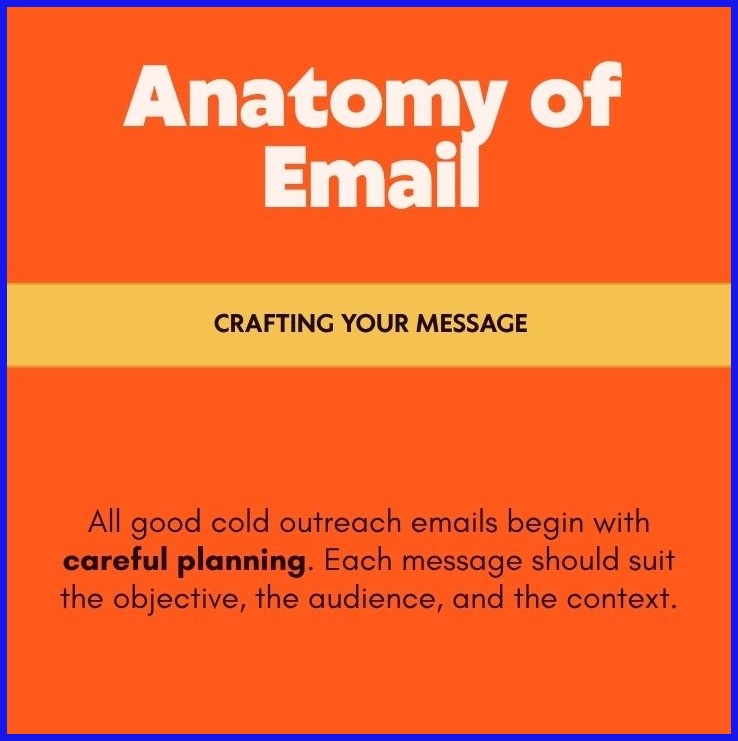
At its root, a winning cold email introduction is one that reaches out on a human level and steers the reader toward one obvious action. Every part of your cold outreach email should have a function towards its primary objective, from the cold email subject lines to the professional email signature. With inboxes jammed and attention spans at a premium, every second, every word counts.
1. The Subject Line
Brief subject lines are best. Shoot for 5-7 words that punch through and complement the email’s body. For instance, ‘Quick question about your site’ or ‘Thought to promote your online sales’. These demonstrate purpose and maintain clarity.
Personalized subject lines, like a recipient’s name or company, see a 10% higher open rate. It’s better than something nebulous like “Important Information” or “Hello.” Humor helps if it suits the industry and your rapport with the reader. Subject lines that make people smile get opened more — a 46% open rate for humor.

2. The Opening Line
The opening two sentences determine whether your e-mail gets read. Readers decide in only 3 seconds. Open with a customized line that shows you know who you’re writing to.
I saw your team introduced a new app last month,” Beats. “I hope this email finds you well.” It demonstrates that you did your research. A direct opener also works: “I help agencies like yours cut reporting time in half.” If you can, add a light, industry-appropriate joke: “Saw your latest campaign—looks like you’ve cracked the code!
Personalization here instills trust and demonstrates respect for the reader’s time.
3. The Value Proposition
Make the value obvious and keep it to one thing. Don’t overwhelm with features or background. Instead, demonstrate that you solve a problem.
Optimize it by humanizing it: ‘Our tool makes all your marketing data one easy dashboard, so you waste less time switching tabs. Describe the value in plain language, no buzzwords. If possible, tie your offer to something relevant for them. For a SaaS buyer, emphasize how your product saves money or integrates with tools they already use.
One idea per email keeps things clear and helps drive action. The value can’t be buried in a long story. Put it somewhere easy to locate, and make sure it’s easy to read for people anywhere in the world. Use numbers or facts when you can, like ‘Save up to 5 hours each week on reporting’. This provides your offer with eft and credibility.
4. The Call-to-Action
Your CTA needs to be convenient and low-risk. Don’t request too much. Can we schedule a quick call next week?” or “Want a short demo?” beats “Sign up for our annual plan now.” It’s more likely that readers will do it if the action is small.
Be specific about your needs. Don’t use ambiguous asks like ‘Let me know what you think.’ Direct CTAs receive more responses. Follow-up is important. Schedule at least one follow-up, but two or three is optimal for the vast majority. Keep it brief.
5. The Signature
A good signature tells them who you are and how to contact you. Don’t forget to SIGN it with your name, title, company, and one connection method, such as a phone number or website.
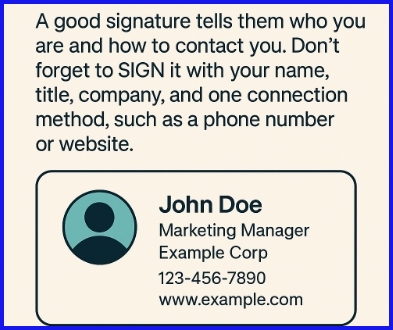
Stay away from big quotes or images that won’t load for everybody. Straightforward wins.
Here’s an Example Cold Email Template You Can Use
Now that we’ve broken down the key components of a high-converting cold email introduction, let’s put it all together. Below is a cold email template you can copy, paste, and tweak to suit your target audience and offer.
“Subject: Quick idea to improve {their company name} (Alternative options: “{Name}, thought you’d find this useful” or “Quick question about your {marketing/sales/etc} flow”)
Hi {First Name},
I noticed something specific about their business — ex., “your team recently launched a new feature on your app” or “your blog post on X resonated with our team.” Thought I’d reach out with a quick idea in this cold outreach email.
I help {target audience — ex., “agencies like yours” or “B2B SaaS companies”} {clear value proposition — ex., “automate weekly client reporting and save 5+ hours a week”}. Our tool, {Tool/Service Name}, plugs right into {mention relevant tools or workflow} and makes {result — ex., “dashboard creation almost instant”} through our innovative cold email software.
Would you be open to a quick 10-minute call sometime this week to see if it’s a fit?
Let me know what works best — happy to keep it short and valuable.
Best, {Your Full Name} {Your Role, Company} {Phone or Website} {LinkedIn URL or Email (optional)}”
Crafting Your Message
All good cold outreach emails begin with careful planning. Each message should suit the objective, the audience, and the context. Recipients today receive more unsolicited emails than ever, so a generic message won’t be memorable or garner a positive response. The trick is to demonstrate that you ‘get’ what they need and keep it straightforward and authentic.
Research
Begin with research. Discover what is important to the person or company you wish to contact. Notice anything new, issues they have, or news about their industry. Leverage public information like company blogs, LinkedIn posts, or press releases. For instance, note if you see a company recently rolled out a new product. This demonstrates you made an effort to get to know them.
Do more than just spit facts. Notice any industry trends or challenges. If you sell tech tools and find out their team is using the older tools, make a note of it. You can then demonstrate how your proposition aligns. Always keep the research specific and connected to your message.
Personalization
Personalization is now a necessity in cold email campaigns. Utilizing the person’s first name and company name is elementary. Push it. Customize your message for the person’s role, recent work, or pain points. For instance, “Hey Priya, I saw that GreenLeaf Inc. just launched a branch in Berlin. They have hiring slowdowns in this stage as well; many firms do. We assist businesses in accelerating the onboarding process for new teams through effective cold outreach emails.
Messages that are personalized increase open rates by a minimum of 10% more than generic ones. Reference a struggle or goal important to them. No name-swapping templates. Prospects can tell when you copy-paste, and they hardly ever respond to those unsolicited emails.
Keep the note casual but specific. Don’t attempt to make a sale on the spot. Instead, show you understand their needs and want to talk. One quick line, such as ‘Would you be open for a brief chat next week to see if we can assist?’ seems no-pressure and encourages a positive response.
Frameworks
Organization is crucial when writing cold emails. An easy framework to follow is the “Opening–Pain Point–Value–CTA” sequence. Start with a hello and a line that shows you know the potential client. Next, mention a challenge they might face. After that, explain how you can help them with your cold email campaign. Finally, conclude with a simple, low-commitment CTA, like “Is it okay to forward additional info?” or “Can we schedule a brief call?”
Another great style is the “Question–Insight–Ask” format. Start with a question about their business, throw in a rapid-fire insight, and request that they respond. For example: “Are you finding it hard to track marketing KPIs? A lot of managers, however, report that spreadsheets hinder them. Want to see an easier way?
Tone
Make it conversational. Use short words and keep sentences clean. Ditch buzzwords and padding. Write as if you’re speaking to a peer.
Make sure each message feels human. Never try to sell too soon. Always aim to spark a real talk.
Strategic Email Frameworks
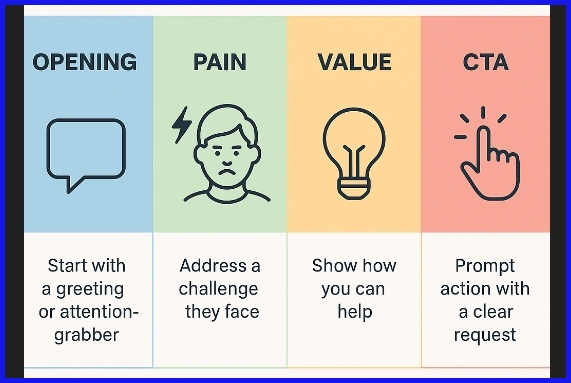
The cold email strategy can help sales teams break through the clutter and reach decision-makers everywhere. The right frameworks foster trust and open and reply rates, and establish clear next steps for the recipient.
Three battle-tested problem, value, and connection strategies steer cold outreach.
Problem-Focused
Begin with the recipient’s challenge. Your pain point, or your business’s pain point, as a “PAS” (Problem, Agitation, Solution) template, would be outlined. Agitate mildly—demonstrate that you know how that problem affects their work/accomplishments.
Present a straightforward, lightning bolt fix in a line or two. For instance, “Most SaaS teams can’t track marketing ROI. Without the right data, budgets are squandered. KPI.me makes all an agency’s marketing metrics visible at once, slashing reporting time in half.
Personalization counts in this regard. Emails that either open with the person’s name or mention their company are memorable. Research demonstrates that a personalized first line doubles response rates and increases open rates by approximately 10%.
Even a brief nod to a recent company achievement or mutual industry struggle can matter. Short, direct, and customized to the recipient’s context works best.
Value-Driven
Emphasize obvious advantages. Readers want to know what’s in it for them. Concentrate on the result your product or service provides. Just use data or examples to demonstrate the impact.
For example, “Our tool marketing agencies save 5 hours per week per user.” Keep the structure simple: personalize, offer value, and include a call-to-action. A specific CTA, for example, “How about a 10-minute demo this week?” works well.
When testing, switch up just one element—such as the subject line or CTA—to find out what generates the most response. A/B testing is useful, but systematic. If you switch up the offer and the introduction, you’ll never know what made a difference in the results.
This rigorous testing discipline results in cleaner insights and better emails. Quick emails are effective. One-sentence emails do well, especially if they get straight to the point and respect the reader’s time.
A small value statement and a focused ask are usually sufficient to generate a response.
Connection-Based
Establish rapport by citing common interests, mutual contacts, or recent accomplishments. If you saw the recipient’s company in the news, reference it. For instance, ‘Saw your team just launched a new feature—congrats!’ A little bit of authentic appreciation can do wonders.
Include the recipient’s name in your subject line and greeting. Along the same lines, relevant, snappy subject lines increase open rates, so stay away from vague or generic phrases.
‘Quick question about your new marketing strategy’ works better than ‘Hello’ or ‘Introduction.’ A warm, relatable tone builds trust. Even in short outreach, authenticity shines.
Try to begin a dialog, not a sales pitch.
Beyond the First Email
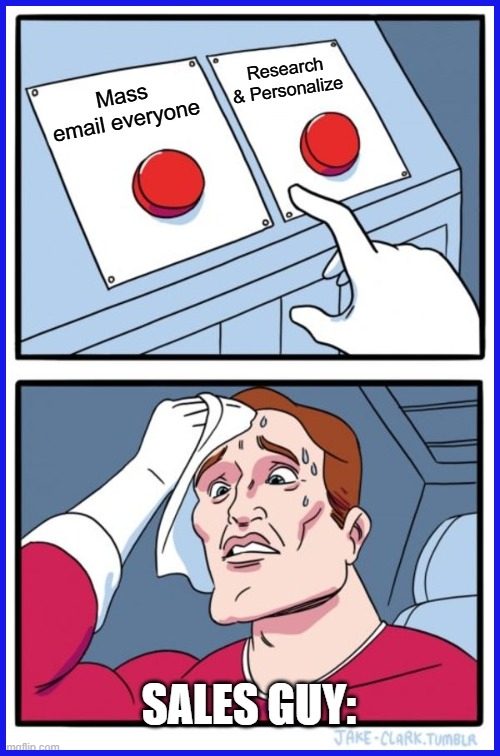
Just like it’s standard to follow up beyond the first cold email. Today’s recipients can smell a batch-and-blast or stale chase email; therefore, each follow-up needs to be value-additive, demonstrate relevance, and concentrate on establishing trust. It’s a process that extends beyond the first email.
Timing, personalization, and tracking all impact outcomes.
The Sequence
A good email sequence is more than a schedule of send dates. Each email should build on the previous. Your initial note could present your opportunity candidly. Your follow-up might respond to a potential objection, provide a case study, or new query.
You can send 7-10 emails, spaced out over a month, without being a pain, so long as each one is respectful and does not rehash the same pitch. For instance, following up the first email with a second that proposes a brief call, while a third emphasizes a specific advantage or new feature.
Some users return to stale threads a few weeks after an initial “no,” so it can pay off to follow up with a gentle, value-based note down the road.
The Metrics
Personalization isn’t just about a name – it’s about demonstrating that you understand the recipients’ needs. Personalized emails can increase click-through rates by 14% and conversions by 10%.
Monitoring open rates, click rates, and conversions lets you know what resonates and what falls flat. A/B testing is key. Experiment with different subject lines, body text, or CTAs on your follow-ups.
Test to see which ones get more clicks or replies. For instance, requesting a fast call as opposed to requesting a response can have very different results. Apply these insights to polish your strategy, making sure each email is value-added and more likely to receive a reply.
Common Cold Email Pitfalls
Little errors in cold email introductions can lead to dismal response rates and damaged credibility. As well-written as a good cold email copy needs to be, it must avoid simple traps that either drive readers away or end up in the spam folder. By understanding these pitfalls, your sales team and agency can effectively engage with potential clients in a more efficient, authentic manner.
Self-Centered Language
Focusing exclusively on what YOU want rarely yields results in cold email campaigns. Many cold emails highlight the sender’s features or accomplishments instead of showcasing actual value for the message recipient. This self-centered approach can transform emails into mere pitches, lacking genuine conversation.
For example, starting with ‘We’re #1 at…’ or ‘Our business just introduced…’ shifts the focus to you rather than your potential clients. This strategy leads to low traction because recipients prefer to know how you can improve their lives, not just what you’re selling.
Incorporating personalization, like including the recipient’s name in cold email subject lines, can significantly enhance email deliverability and increase opens by as much as 39%, while a message tailored to their needs can boost response rates by 45%.
Vague Requests
Vague or general calls to action baffle recipients and decrease the likelihood of a response. A “let me know if you’re interested/please get back to me” provides no clear next step. They respond best to easy, actionable requests, like, “Would you be available for a 10-minute chat next week?
Studies show emails between 50-125 words receive the best response, as high as 50%. Piling on additional information or options can tank response rates. One study shows that adding 100 words can reduce replies by about 15%.
It’s typical to shoot off a single email and wait, but follow-ups are important. Most affirmative responses come after a follow-up, not the initial outreach.
Poor Formatting
Messy formatting, long blocks of text, and unclear structure all make emails difficult to read. Feature list-stuffed emails or ones using ALL CAPS and excessive punctuation (!) appear unprofessional and can even activate spam filters.
Short, clear sentences and lots of white space assist readers in scanning your note. Use bullets for lists and bold for highlights, but don’t go crazy. For best results, send emails on weekdays and during office hours.
Subject lines should be brief and transparent—ambiguous or clickbait lines erode trust, and extended subject subjects decrease opens. 64% of individuals make the open or delete decision based solely on the subject line.
Ignoring Spam Filters
Neglecting obvious spam filter red flags can prevent your email from ever hitting the inbox. Including multiple links, attachments, or odd formatting frequently shoots messages directly to spam.
Steer clear of all caps, strange fonts, and a ton of symbols. Keep the file size low. Try your emails at worst and see where they land.
Beware of words such as “free,” “guaranteed,” or “urgent.” These are typical spam indicators.
Conclusion
Write short, clear, and real. Use words that sound like you, not a robot. Demonstrate that you care about the reader—reference their work, their brand, or a destination they want to reach.
Avoid the hard sell. Request a little step, not a giant leap. Make your subject straightforward and truthful. Provide a why to respond.
Everyone receives umpteen emails daily, so be memorable with a human touch and a direct request. Experiment with a couple of lines, shuffle the language, and see what draws the responses.
Want to see what clicks for your team? Just configure a brief report with KPI.me and monitor your email triumphs.
Frequently Asked Questions
What is the key to a successful cold email for sales?
The trick is personalization in cold outreach emails. Get their name, demonstrate you understand their needs, and provide an obvious benefit for a positive response.
How long should a cold sales email be?
Preferably, keep your cold email introduction under 150 words. Short cold outreach emails are more likely to be read and elicit a positive response.
When is the best time to send a cold sales email?
To enhance your cold email campaigns, try sending your emails on weekdays, preferably in the morning, as timing can boost your open rates.
What should I include in the subject line?
Utilize a direct and descriptive subject in your cold email introduction. Reference a benefit or something the potential client cares about to increase your cold email open rates.
How soon should I follow up after sending a cold email?
Hang for three to five days and then follow up with a cold outreach email. Make your follow-up short and mention your initial message.
How can I avoid my cold email being marked as spam?
Avoid using all caps, excessive links, or salesy language in your cold outreach emails. Instead, focus on personalizing your cold email introduction and use a reputable email address.
What is the most common mistake in cold email outreach?
The most prevalent error in cold email campaigns is blasting out generic emails. Always customize for your message recipient and put them first.

